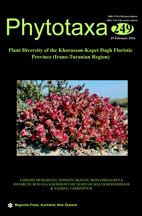Abstract
Khorassan-Kopet Dagh (KK) floristic province located in northeastern Iran and southern Turkmenistan is one of the important centers of plant endemism in Irano-Turanian region. In order to evaluate the plant endemism, distribution and conservation, we generated an updated and annotated checklist of 356 endemic vascular plant taxa belonging to 112 genera and 36 families of angiosperms. The genera Astragalus and Cousinia have the highest number of endemics and the hemicryptophytes are the dominant life form. On the basis of the available distributional data, mainly from herbarium records and reliable references, we analyzed the distribution patterns and diversity of the endemic taxa. The central part of KK has the highest endemic richness, and the least number of endemics occur in the southern part. Mapping the occurrence data of the endemics revealed 16 main distribution patterns. There are only 24 widespread endemics, and more than half of the endemic taxa are restricted to only one of five geographical zones of the area. Analysis of endemic diversity based on 15ʹ grid cell maps showed that the Central part of Kopet Dagh range, Aladagh and Salook ranges and Golestan National Park are located in the areas with the highest endemic richness. Mapping the beta diversity of the grid cells revealed the vast areas of the Central part, following some areas of the Eastern, Western and Northwestern parts, are highly differentiated by composition of endemic plants. All of the KK endemic taxa were evaluated against the IUCN Red List categories and criteria and a total of 200 endemic taxa were globally classified as threatened including 24 Critically Endangered, 72 Endangered and 104 Vulnerable taxa. Areas with the highest threatened endemics richness are located in Central Kopet Dagh range along Iran-Turkmenistan border, Golestan National Park and adjacent Ghorkhod Protected area, Aladagh and Salook ranges, and the eastern part of Binalood range. Implications of the results in conservation prioritization of the endemic taxa and also of the geographical areas are discussed. As far as possible the taxonomic status of known endemics are critically checked, type specimens of some doubtful taxa are consulted, and representative vouchers of reported species are given. The new species Heliotropium khayyamii Akhani sp. nov. is described and seven taxa are placed as new synonyms: Astragalus salehabadensis Ranjbar & Zarin (= A. basineri Trautv.), A. torbathaydariyehensis Ranjbar & Zarin (= A. basineri), Astragalus ghouchanensis Souzani, Zarre & Maassoumi (= A. sumbari Popov), Cousinia golestanica Attar (= C. stahliana Bornm. & Gauba), Centaurea bojnordensis Ranjbar, Negaresh & Joharchi (= C. sintenisiana Gand.), Cyanus persicus Ranjbar & Negaresh (= C. depressus (M. Bieb.) Soják) and Klasea nana Ranjbar & Negaresh (= K. latifolia (Boiss.) L.Martins). Twenty-five taxa with poor taxonomic evidence are listed separately as doubtful. Distribution maps of almost all known endemics are provided.

